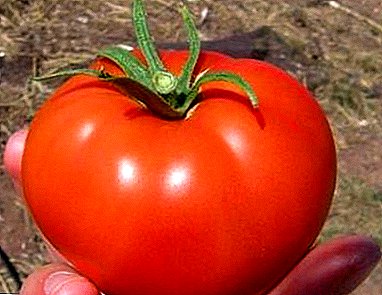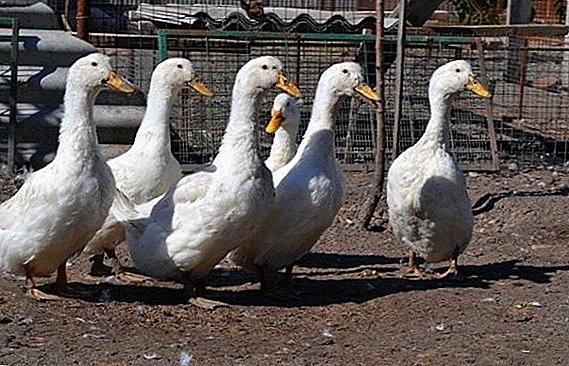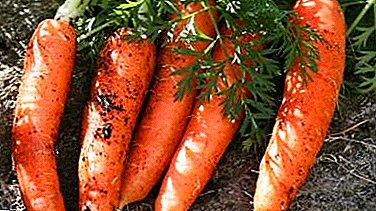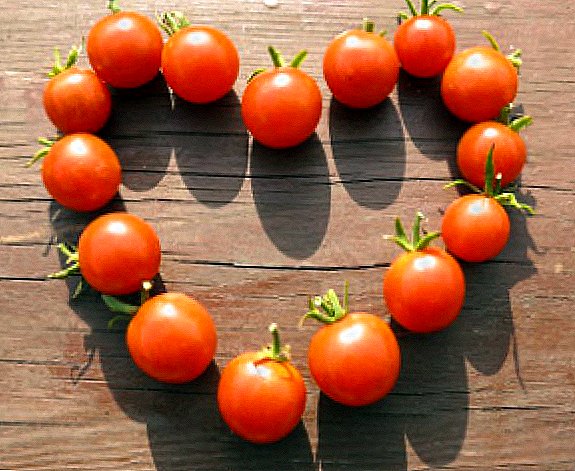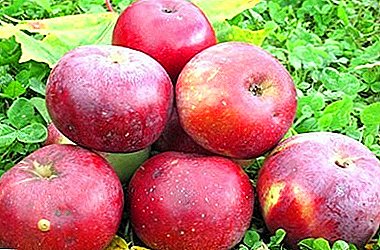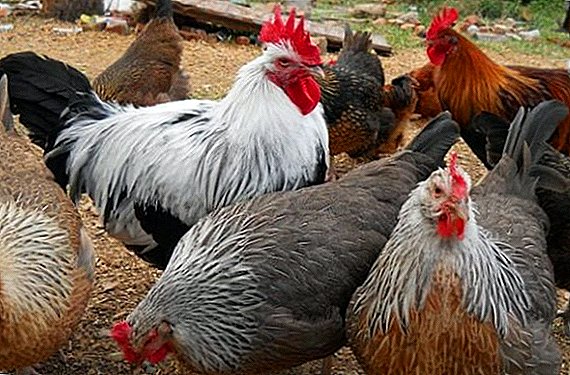 Dorking - breed of chickens, which is considered one of the best in the meat direction. Representatives of the breed have an attractive appearance, and their meat is juicy, soft and has a rich protein composition. Birds are distinguished by high production of meat products and are often preferred by farmers engaged in meat chicken production.
Dorking - breed of chickens, which is considered one of the best in the meat direction. Representatives of the breed have an attractive appearance, and their meat is juicy, soft and has a rich protein composition. Birds are distinguished by high production of meat products and are often preferred by farmers engaged in meat chicken production.
Description breed Dorking
Chickens breed Dorking - real English aristocrats. The beginning of the breed is officially dated only to 1874, although the first representatives have already participated in exhibitions since 1845. The birds were bred in the small town of Dorking in Surrey, England.
The purpose of the selection was to create a chicken in the meat direction, which could quickly gain weight and tolerate not very favorable weather conditions in England - high humidity and rainy.
Ancient Roman chickens took part in the selection work. They were brought to the British Isles by the Romans a very long time ago - almost 2 thousand years ago, namely - in the I century after the birth of Christ.
These birds had a good weight, grew quickly, but could hardly tolerate local climatic conditions, and therefore often sick and died. Breeders decided to create a new breed of chickens that could tolerate the high humidity of the UK.  For this, Roman chicken hens were crossed with local native breeds, which did not give a good meat yield, but were perfectly adapted to the natural conditions of the British Isles.
For this, Roman chicken hens were crossed with local native breeds, which did not give a good meat yield, but were perfectly adapted to the natural conditions of the British Isles.
In order to obtain meat, such breeds of hens are grown as langshan, la flush, brahma, Jersey giant, kohinquin, cornish, plymouthrock, orpington, and fireball.
Thus, the Dorking meat breed was bred, named after the town where it was first revealed to the world. However, the official recognition of the breed was not immediately given to the conservative English.
The breed standard was recognized almost 30 years later, thanks to scientists from America who showed interest in the newly-born layer. And although today dorkings remain quite capricious birds, with proper care, they are able to withstand temperature extremes, low humidity and winter cold.  The high rate of meat production and the possibility of raising birds in the middle latitudes made these chickens very popular among poultry farmers.
The high rate of meat production and the possibility of raising birds in the middle latitudes made these chickens very popular among poultry farmers.
External signs
The breed standard of Dorking is characterized by the following features of the exterior of the bird:
- head rather large, with wide forehead;
- the crest is leaf-shaped or sometimes rosy, very large and upright in roosters, and in smaller chickens and bent to one side;
- the beak is small, the tip is bent down;
- earrings are medium, wide, rounded;
- the neck is short and wide;
- the body is large and massive, quadrangular in shape, oblong and wide;
- the wings are wide, developed, tight to the sides;
- the back is wide, but closer to the tail is slightly narrowed;
- chest broad, developed, muscular;
- the tail is voluminous, large, fan-like;
- legs are large, not long, decorated with thin and long spurs;
- metatarsus of the same color as the beak, most often they are light pink, pale yellow or white;
- plumage fluffy and dense.

Dorking live weight is as follows:
- roosters weigh from 3.5 kg to 4.5 kg;
- The ears weigh from 2.5 kg to 3.5 kg.
The color of the breed can be very diverse, variegated and beautiful.
We recommend to familiarize with a rating of hens of meat productivity.
It is customary to distinguish such basic varieties of color:
- white - birds of bright white color without a single speck of color. Against the snow-white plumage, bright scarlet earrings and combs stand out in contrast;
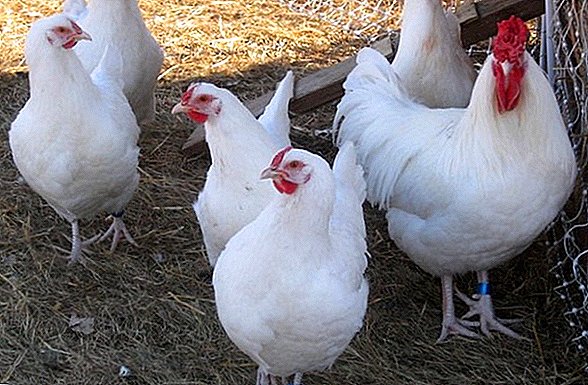
- motley - blue feathers ebb traced throughout the plumage. Moreover, the crests of birds with this color are almost always pinkish;
We advise you to read about whether a rooster is needed for chickens to carry eggs, why chickens peck at each other, how many chickens there should be for one rooster, when chicks of pullets begin to rush;
- silver gray - beautiful silver feathers adorn the neck, wings and back of chickens, but the lower part of the body (chest, abdomen and tail) is completely black;
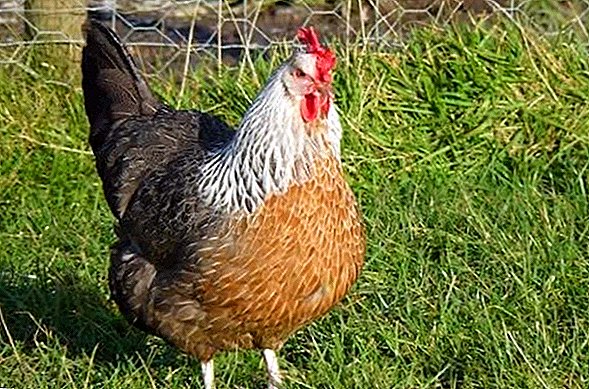
- Japanese - neck, back and loins are decorated with oblong yellowish plumage, and the tail and lower part of the body are black;
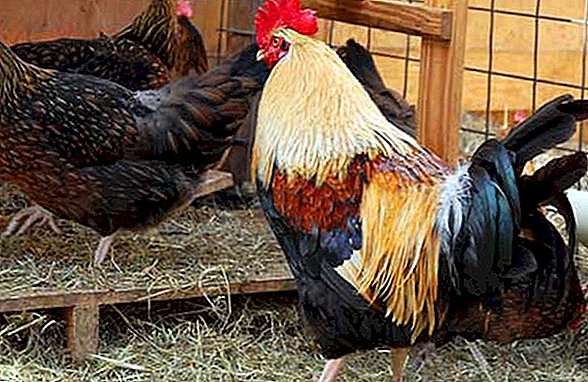
- golden - the upper part of the body has a bright and beautiful red-gold plumage, and the tail and lower part of the body are dark — brownish-gray feathers have black blotches;
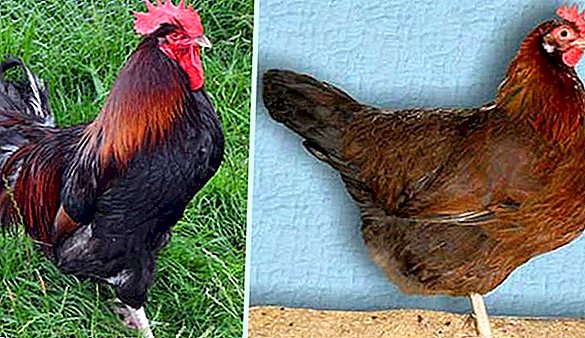
- striped - from above the body of the bird is covered with feathers of a reddish-brown color with white splashes. Whitish dots are noticeable on the black chest and lower legs.
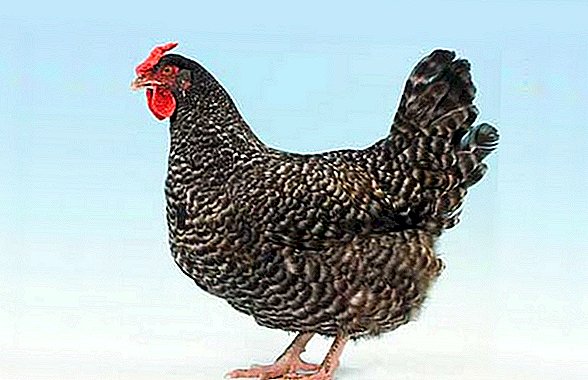
Important! Birds with a white color give less meat and have less productivity than their variegated fellows. However, the quality of their meat is better, richer in proteins and tastier.
Character
The character of the Dorking is pretty good-natured. These birds do not show much love for battles and are not particularly conflicting, although they still occasionally clash. Fighting for primacy between roosters occur most often in too large a herd.
In order to minimize the number of cockfights, it is recommended to breed males in such a ratio that for every 10 klich there would be 1 leader. If there are more roosters, they will often fight and injure each other.  And if there are fewer of them, the number of fertilized eggs and the total egg production of chickens will suffer. By temperament, dorkings are quite active birds. They are curious, and despite their massive dimensions, they love active pastime, so these birds need spacious enclosures, where there is enough space for activity.
And if there are fewer of them, the number of fertilized eggs and the total egg production of chickens will suffer. By temperament, dorkings are quite active birds. They are curious, and despite their massive dimensions, they love active pastime, so these birds need spacious enclosures, where there is enough space for activity.
As for the rest, Dorking hens are not aggressive, not angry, not pugnacious. They have a lively, curious disposition, good-natured and conducive to themselves.
Maternal instinct
Despite the fact that many hybrid breeds of chickens, as a result of breeding works, lose their natural incubation instinct, the dorking can boast that they managed to preserve it.
The ears of this breed become beautiful hens. They hatch eggs well, warming them with their warmth for the entire prescribed period, and then very carefully take care of their young offspring for 2 months.  The surviving instinct of incubation among dorkings and excellent maternal habits allow the young to provide good care, and thus increase its survival rate.
The surviving instinct of incubation among dorkings and excellent maternal habits allow the young to provide good care, and thus increase its survival rate.
Important! Despite the fact that adults are relatively unpretentious to the conditions of detention and can, without harm to themselves, tolerate temperature drops, their offspring in the first three weeks of life are extremely sensitive to environmental conditions.
The chicks are very afraid of drafts and cold, and very much in need of high-quality, nutritious and rich in vitamins, minerals feed. And mothers help protect chickens from adverse conditions, warm them, protect them and wear a brood until they become completely independent. 
Advantages and disadvantages of the breed
Breed Dorking favorably with the following advantages:
- high meat productivity;
- excellent taste and quality characteristics of meat products;
- the early term of maturation of hens;
- quick weight gain in young animals;
- developed instinct nasizhivaniya;
- attractive appearance.
However, in addition to the obvious advantages, dorking have some disadvantages:
- whimsical to conditions of detention and nutrition;
- the increased demands of chicks on the conditions of detention in the first three weeks of life;
- average egg production;
- special need for high-quality nutrition in pullets that mature early, not yet completed growth.

Ripening and egg production
Chickens of the Dorking breed are precocious, because their sexual maturity comes very early - in the 4th month of life. This is fraught with the fact that young chickens begin to lay eggs when they themselves still continue to grow.
Important! Malnutrition in young birds leads to the fact that by the time of puberty, the clubs are still underdeveloped. Fast earliness directly depends on the nutritional value of feed and the regularity of feeding. If you follow the diet, chickens grow quickly, start to nest early and have good health.
And because they have an increased need for nutrition, rich in vitamins, proteins and trace elements, in particular, they have an increased need for calcium. Egg laying at dorkings is average, which is very good, because the breed is considered purely meat.  In the year chickens produce from 120 to 140 pieces of egg products. In the first year of egg production, these figures may be slightly higher. Egg weight is small or medium - from 55 g to 65 g. The color of the shell is white.
In the year chickens produce from 120 to 140 pieces of egg products. In the first year of egg production, these figures may be slightly higher. Egg weight is small or medium - from 55 g to 65 g. The color of the shell is white.
Chickens breed Dorking
Despite the fact that adults are relatively hardy, their cubs in the first three weeks of life are very weak and sensitive to adverse conditions. In particular, the chicks are very afraid of drafts and not enough warm air temperature.
Important! Culling chickens can prevent the disease of all broods and herds in case any chick is sick, and also contributes to preserving in the future only strong and viable individuals, which only strengthens the parent flock and helps to breed more and more powerful subsequent generations.
Increased dampness and humidity are detrimental to young animals. When purchasing chicks on the market or getting a new brood from under the hen, you should always carefully inspect the birds and discard the weak and sick.  So, chickens are subject to culling, which are:
So, chickens are subject to culling, which are:
- covered with too rare fluff or if they have bald patches;
- have crooked legs with defects;
- have a colorless and too pale color;
- have a crossed beak;
- look weak, inactive, poorly eaten;
- have indigestion and are soiled with liquid drips.
The color of the young is difficult to determine what will be the plumage of an adult bird, because the fluff they have completely changed to adult plumage. However, some patterns exist. It is noticed that light brownish down of chicks indicates that adults will have Japanese or golden color.
Motley representatives at an early age have more saturated down, the wings and back are dark, and there are light stripes on the back, but the tummies are white. In white representatives of the breed cubs have an unusual silver gun. 
Chicken Feeding
Feeding chickens from the first days of life should be very nutritious, rich in proteins, vitamins and trace elements. The pledge of health not only of young animals, but also of future adults is precisely in the rich diet from birth.
Learn how to feed chickens in the first days of life, what to give to chickens, how to give them greens, how to use an infrared lamp to heat chickens.
Nestlings grow very quickly and rapidly gain weight, their body makes higher demands on the nutritional value of feed than other breeds of chickens, because they need to satisfy the needs of the actively growing organism.
Video: chick feeding The feeding regime and diet should meet the basic requirements:
- From the first day of life, chickens are given wet warm mash potatoes, which are prepared from hard-boiled eggs, finely ground cereals, with the addition of oatmeal and dairy products.
- Dairy products are needed by small dorkings to satisfy the ever-increasing need for calcium. Therefore, chicks can be fed with yogurt or cottage cheese.
- From the third day of life, you can begin to add various finely chopped greens to the mash. It can be alfalfa, clover or nettle. Before adding herbs to the mash, be sure to scald with boiling water to kill the pathogens that may be contained in them.
- Also useful for kids will be the presence in the diet of boiled vegetables. These can be, for example, pumpkin and carrots. Vegetables are boiled and mashed to the consistency of mashed potatoes, then added to the mash.
- The availability of only greens and vegetables for Dorking breed chickens is not enough for full growth.
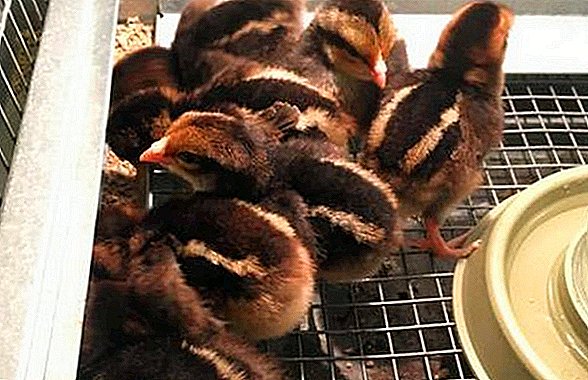 Their increased needs require specialized ready-made vitamin and mineral supplements. It is necessary to add them to the feed according to the instructions and the age of the chicks.
Their increased needs require specialized ready-made vitamin and mineral supplements. It is necessary to add them to the feed according to the instructions and the age of the chicks. - Bone and fish meal are indispensable supplements in the nutrition of young and adult chickens.
- Chickens should have constant access to clean and fresh drinking water. They should not be thirsty. To avoid many infectious diseases, a very weak solution of potassium permanganate can be added to the water.
After three weeks of life, chicks can begin to transfer to adult food.
Important! It is necessary to prepare the mash immediately before each feeding. Early preparation and even short storage contribute to the reproduction in the wet protein feed of pathogens to which the young are particularly sensitive.
Nursing care
Care for dorking cubs in addition to feeding should take into account two important factors - temperature and humidity.  Chickens are extremely sensitive to temperature extremes and will die with a significant drop in temperature.
Chickens are extremely sensitive to temperature extremes and will die with a significant drop in temperature.
At first, they have a rather precarious health, so the first three weeks they should be kept in a well heated room. Temperature readings should be within +30. After this time, the air temperature must be lowered by 3 ℃ every week.
Since this indicator is high for an adult flock, the brood hen is kept in a separate room, equipped for the needs of the younger generation. The temperature mode is maintained with the help of heating devices.
Excellent for this task cope infrared lamps. The optimum temperature can be judged by the behavior of chicks. Cubs, which freeze, will be pressed to the source of heat, heap and cringe.
Video: proper nutrition and maintenance of chickens If overheated, they will keep away from the heat source, will appear sluggish and thirsty. If the temperature is optimal and the chickens are comfortable, they are cheerful, active, inquisitive, they will squeak, look at each other and go about their "bird" affairs.
The second vital indicator is humidity. It simply should not be. Nestlings are very afraid of damp, they get sick and die in conditions of high humidity. Therefore, the place of their content should be dry and warm, without the slightest condensate.
Do not forget about good ventilation. It should not be drafts, but the air also can not stagnate, as this will contribute to the accumulation of moisture, and the air will be stale and stale.  The litter is another nuance in keeping chickens, as it can become a source of accumulation of excessive moisture, dirt, droppings, food debris, and, as a result, it becomes a source of reproduction of pathogenic bacteria.
The litter is another nuance in keeping chickens, as it can become a source of accumulation of excessive moisture, dirt, droppings, food debris, and, as a result, it becomes a source of reproduction of pathogenic bacteria.
Did you know? English ornithologist Joe Edgra proved that chickens are capable of experiencing emotions and even empathy. They are sad and happy, able to become attached to each other or to a person, and even can empathize.
Therefore, the litter should always be clean and dry. It is necessary to clean it every day, but preferably two or three times during the day.
Materials for bedding can be sawdust, straw, hay. The main thing is that it is warm and dry. As it gets dirty, the litter is gradually replaced. 
Content and cultivation
Like chickens, an adult herd needs warmth and dryness. It is necessary to constantly and carefully monitor the livestock, isolate the diseased birds, feed them well and regularly, as well as prevent factors that can cause the death of the livestock.
The premises of the chicken coop must be well insulated and dry. Here drafts are unacceptable. Also, the house must be equipped with all necessary for birds devices - drinkers, feeders, cozy nests, roosts at medium height and ash baths.
Good ventilation is a necessary attribute of the bird house. Air should not stagnate, and moisture should not accumulate. At the same time, the occurrence of drafts must be avoided.  Dry floor and clean bedding - the guarantee of health of the herd. The litter needs to be changed regularly to prevent accumulation of litter, dirt and food debris. It is necessary to warm the floor well. Birds should walk regularly.
Dry floor and clean bedding - the guarantee of health of the herd. The litter needs to be changed regularly to prevent accumulation of litter, dirt and food debris. It is necessary to warm the floor well. Birds should walk regularly.
However, if it is cold, rainy or windy outside, then the hens should be left indoors. Walking is allowed only if the temperature on the street is above -8.
Nutrition
The nutrition of the adult herd, as well as the young, must be rich and nutritious, otherwise the birds will be weak, and this will adversely affect not only weight gain, but also egg production.
We advise you to read about how to give bran, meat and bone meal, fish oil and yeast to chickens, and whether it is possible to give bread and foam plastic to chickens.
Adults are usually fed wet mash once a day and twice as a grain.  They are prepared from a complex of various products or ready-made feed. The grain from the combined feed is best suited.
They are prepared from a complex of various products or ready-made feed. The grain from the combined feed is best suited.
Read more about how to germinate wheat for chickens, what types of feed there are, as well as how to make mash and feed for chickens.
Dorking diet should include:
- зерновые - пшеницу, кукурузу и ячмень;
- fresh greens, in winter, you can replace the germinated grain;
- soybean meal;
- sunflower cake;
- bone, fish and grass meal;
- boiled vegetables and root vegetables;
- powdered milk;
- chalk, crushed shell, fine grained gravel;
- hydrolysis yeast;
- ready-made vitamin supplements that are especially needed during puberty, in the first year of egg production and chickens during brooding.
Video: chicken diet The basis of the diet of chickens breed Dorking should be high-quality high-protein feed. You can periodically add worms, meat waste and dairy products to the mash.
Light and thermal conditions
Chickens require a lot of light and a long light day. Their well-being and indicators of egg production depend on this, because chickens rush only if there is enough light.
Thus, the light day of an adult herd should last about 16 hours. It is necessary to save in the winter. Therefore, the chicken coop must be equipped with additional lamp lighting.
To save on electricity in the winter, you need to ensure that the house has several windows that are located on the south side - this will provide a longer natural daylight day during the cold season.  As for the temperature regime, adult individuals need a temperature in the house from +11 to + 19. If the chicken coop is warm enough, and the winters are not too harsh, then additional heating may not be necessary. Note that this temperature is suitable only for those individuals who have already turned a month. Juveniles need a warmer temperature, which gradually decreases.
As for the temperature regime, adult individuals need a temperature in the house from +11 to + 19. If the chicken coop is warm enough, and the winters are not too harsh, then additional heating may not be necessary. Note that this temperature is suitable only for those individuals who have already turned a month. Juveniles need a warmer temperature, which gradually decreases.
Disease and treatment
Chickens breed Dorking in case of non-compliance with the rules for the care may be sick.
It will be useful for you to read about the symptoms and methods of treatment of diseases of chickens.
They are most prone to the following diseases:
- Peroedy - ticks that parasitize on bird feathers, because of which the feathers are often punctured with small holes. Chickens are itchy and restless. The disease is treated with insecticidal drugs "Arpalit" or "Insectol".
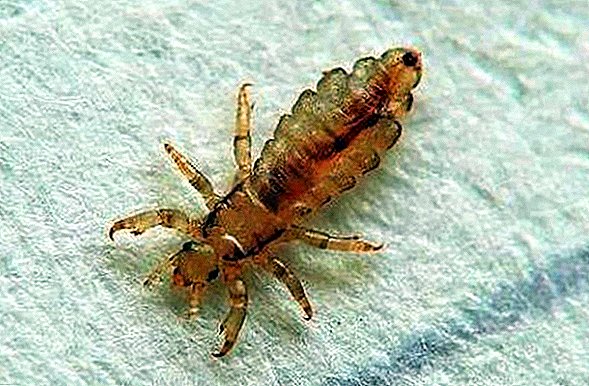
Did you know? In the chicken "society" there is a clear hierarchy, but the patriarchy rules. Cock - the real leader of the herd. It regulates the regime, notifying about the beginning of the day in the morning and about otboyu in the evening, calls for the detected food and protects chickens from predators.
- Helminths - affect the internal organs of birds. Chickens lose weight, become lethargic, there is digestive upset, appetite disappears. It is treated with anthelmintic drugs that only a veterinarian can prescribe, depending on the type of worms that hit the chickens. For prophylaxis, the whole herd is usually treated at once.
- Pasteurellosis or avian cholera - Disease of 2 or 3 month old chicks.
 Accompanied by lethargy, increased thirst and fever, often with diarrhea, and combs and earrings turn blue. It is treated with sulfamide preparations.
Accompanied by lethargy, increased thirst and fever, often with diarrhea, and combs and earrings turn blue. It is treated with sulfamide preparations. - Salmonellosis or paratyphoid birds - Most often young individuals are sick, although there are cases of illness and adult birds. In sick chickens, heightened teariness appears, the eyelids swell up and close, limping and breathing appear, and frothy diarrhea occurs. Treat with furazolidone.
- Infectious bronchitis or nephrosonephritis - affects the reproductive organs of adult birds and respiratory organs in young. Egg production is stopped for a long time.
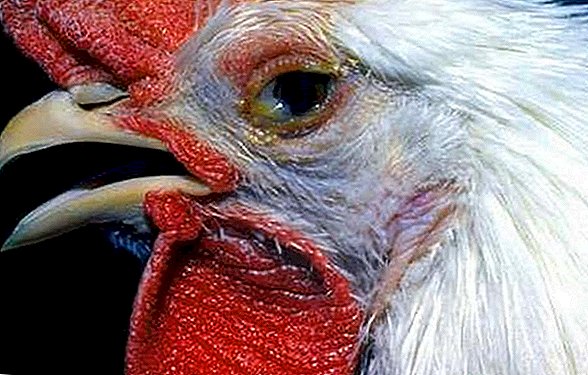 Patients with cough, rhinitis, diarrhea and depression. Treatment can not be.
Patients with cough, rhinitis, diarrhea and depression. Treatment can not be. - Bird flu - young animals do not get sick before the 20th day of life. The disease leads to damage to the respiratory and gastrointestinal tract. In birds, breathing becomes difficult and hoarse, earrings and a comb turn blue, a bird is sluggish, body temperature is elevated, and diarrhea often occurs. Treatment can not be.
- Newcastle disease or atypical plague. Also called bird encephalitis. Mainly young animals are sick, and in adult birds it is often asymptomatic. It affects the nervous system, gastrointestinal tract and respiratory organs. The brightest symptom is a lack of coordination of movements, the bird trembles, falls, falls to the side, walks in circles. Drowsiness, fever, accumulation of mucus in the mouth and nose are observed, the comb is blue, and the swallowing reflex disappears. The disease is terrible, treatment can not be and is transmitted to man.
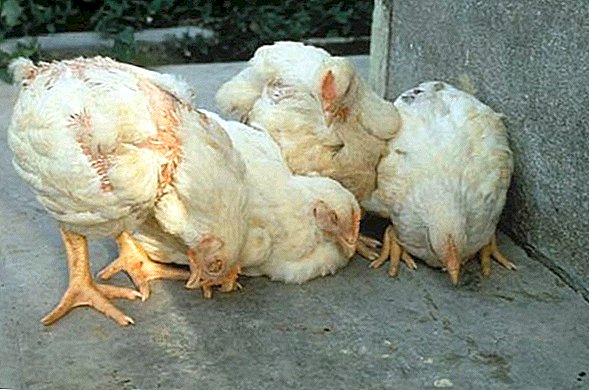 When identifying at least one diseased individual in the herd, all the livestock shall be destroyed. Corpses are burned or buried deep, pre-sprinkled with lime. These are necessary measures, as the virus is extremely contagious and tenacious, leading to a 100% loss of the herd.
When identifying at least one diseased individual in the herd, all the livestock shall be destroyed. Corpses are burned or buried deep, pre-sprinkled with lime. These are necessary measures, as the virus is extremely contagious and tenacious, leading to a 100% loss of the herd.
Important! Since many avian diseases do not respond to treatment and are dangerous for humans, birds of the Dorking breed at a young age (before puberty) are vaccinated against major dangerous diseases. - Newcastle disease, salmonellosis, bird flu and other parasitic and viral diseases.
English hens of breed Dorking - "pleasure" not for the beginning poultry breeder. These layers, while possessing excellent performance characteristics, are still quite whimsical to the conditions of detention.  Without proper care, the birds will be sick, which will only cause damage, besides, some bird diseases are highly infectious and are transmitted to humans.
Without proper care, the birds will be sick, which will only cause damage, besides, some bird diseases are highly infectious and are transmitted to humans.
Did you know? Scientists have proven that chickens can communicate. All those sounds that we used to call clucking and crowing are in reality nothing but chicken speech. It has up to 30 different variations and forms, which are hardly visible to the human ear.Starting a dorking on your farm is only if you are confident in your abilities and can provide them with proper care.







 Their increased needs require specialized ready-made vitamin and mineral supplements. It is necessary to add them to the feed according to the instructions and the age of the chicks.
Their increased needs require specialized ready-made vitamin and mineral supplements. It is necessary to add them to the feed according to the instructions and the age of the chicks.
 Accompanied by lethargy, increased thirst and fever, often with diarrhea, and combs and earrings turn blue. It is treated with sulfamide preparations.
Accompanied by lethargy, increased thirst and fever, often with diarrhea, and combs and earrings turn blue. It is treated with sulfamide preparations. Patients with cough, rhinitis, diarrhea and depression. Treatment can not be.
Patients with cough, rhinitis, diarrhea and depression. Treatment can not be. When identifying at least one diseased individual in the herd, all the livestock shall be destroyed. Corpses are burned or buried deep, pre-sprinkled with lime. These are necessary measures, as the virus is extremely contagious and tenacious, leading to a 100% loss of the herd.
When identifying at least one diseased individual in the herd, all the livestock shall be destroyed. Corpses are burned or buried deep, pre-sprinkled with lime. These are necessary measures, as the virus is extremely contagious and tenacious, leading to a 100% loss of the herd.